Tetras (Paracheirodon Axelrodi) are among the most popular and vibrant freshwater fish, adorning aquariums across the UK. Hailing from the warm waters of South America, these colourful swimmers boast a spectrum of hues and patterns, making each species uniquely delightful.
Remarkably, despite the vast diversity ranging from the neon tetra to the cardinal tetra, many of the tetra species have similar care requirements. A little-known fact about tetras is their ability to communicate through low-frequency sounds, an attribute not commonly found in other aquarium fish.
This shared sonic language, coupled with their common care needs, showcases the intriguing blend of diversity and unity within the tetra family.
Table of Contents
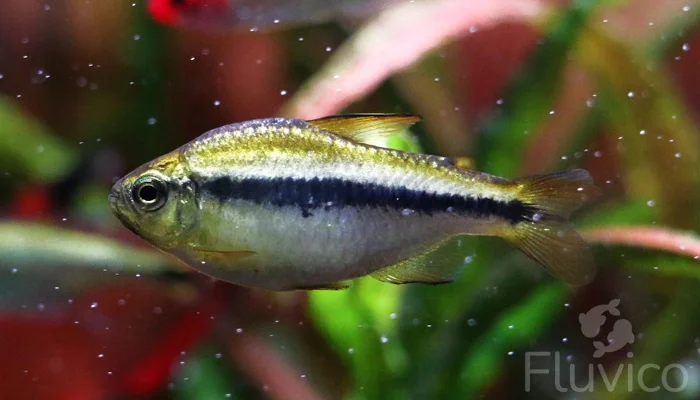
Facts & Overview
| Tetra Fact: | Details: |
| Scientific Name: | Paracheirodon Axelrodi |
| Common Names: | Tetra, Neon Tetra, Cardinal Tetra and many more |
| Care Level: | Easy to Moderate (depending on species) |
| Native Region: | Freshwater rivers and streams of South and Central America |
| Lifespan: | Up to 5-10 years in optimal conditions (varies by species) |
| Size: | Generally 2-5 centimetres (varies by species) |
| Family: | Characidae |
| Diet: | Omnivore, with some species leaning towards micro-predatory |
| Minimum Tank Size: | 10-20 gallons (40-80 litres) for a small school, depending on species |
| Compatibility: | Peaceful; best in schools and with other non-aggressive fish. |
Natural Habitat for Tetras
Originating from South America’s tropical regions, tetras predominantly thrive in clear, slow-moving streams and densely vegetated riverbanks. These habitats offer a combination of soft, acidic water and a plethora of hiding spots, crucial for their protection and wellbeing.
This environment’s subtle light filtration, provided by the overhead canopy, plays a pivotal role in their radiant colouration. If one aims to replicate their habitat in home aquariums, mimicking these natural conditions is paramount for the tetras’ optimal health and vibrancy.
Understanding and respecting their native surroundings ensures our tetras feel right at home, even miles away from their origins.
Serenity and Its Importance
Serenity, the state of calm and peacefulness, plays a pivotal role in the wellbeing of aquatic life, including tetras. A serene environment reduces stress, promoting healthier growth and more vibrant colours in fish.
For tetras, which naturally inhabit tranquil waters shielded by dense vegetation, a serene tank environment is not just preferable; it’s essential. Such tranquillity boosts their immune system, reduces susceptibility to diseases, and ensures they exhibit their natural behaviours, enriching the overall aquarium experience.
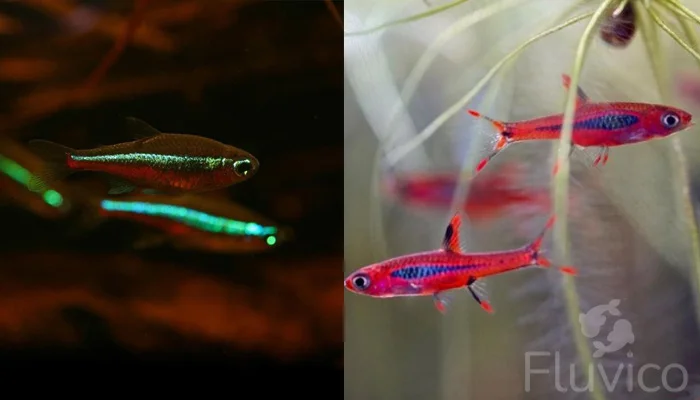
Types of Tetras
Tetras are a diverse group of freshwater fish, with many species each boasting its distinct colours, sizes, and characteristics. While each species has its own unique traits, most tetras share similar care requirements. Here’s an overview of some of the most popular and notable types of tetras:
- Neon Tetra (Paracheirodon innesi): Recognised by their iridescent blue horizontal stripe and red stripe that runs from their midsection to the tail.
- Cardinal Tetra (Paracheirodon axelrodi): Similar to neon tetras, but the red stripe runs the entire length of the body.
- Black Neon Tetra (Hyphessobrycon herbertaxelrodi): Characterised by a horizontal greenish stripe, with a deeper black stripe below it.
- Rummy-Nose Tetra (Hemigrammus rhodostomus): Known for their distinctive red noses and zebra-striped tails.
- Emperor Tetra (Nematobrycon palmeri): Display a beautiful mix of iridescent blue and purple shades.
- Glowlight Tetra (Hemigrammus erythrozonus): Features a prominent reddish-gold stripe running from the snout to the base of the tail.
- Diamond Tetra (Moenkhausia pittieri): Distinguished by their shimmering, silvery scales, which give the appearance of sparkling diamonds.
- Congo Tetra (Phenacogrammus interruptus): Known for their long, flowing fins and iridescent body scales, which shine in blue and orange.
- Bleeding Heart Tetra (Hyphessobrycon erythrostigma): Named for the red blotch on their sides, resembling a bleeding heart.
- Lemon Tetra (Hyphessobrycon pulchripinnis): Characterised by their translucent yellow bodies and red eyes.
- Serpae Tetra (Hyphessobrycon eques): Features a bright red body with a bold black mark on their dorsal fin.
- Bloodfin Tetra (Aphyocharax anisitsi): Noted for their silver body and striking red fins.
- Head-and-Tail Light Tetra (Hemigrammus ocellifer): Their name comes from the bright red spot near the tail and a similar spot on the gill cover.
- Penguin Tetra (Thayeria boehlkei): Named for their unique swimming angle, similar to a penguin’s posture.
- Flame Tetra or Von Rio Tetra (Hyphessobrycon flammeus): Recognised by their fiery red-orange bodies.
While most tetras have general care guidelines relating to tank conditions, water parameters, diet, and companionship, it’s essential to research specific needs for each species before introducing them to an aquarium to ensure their optimal health and well-being.
Tank Setup and Housing Requirements
Tank Size and Its Importance
The size of an aquarium plays a pivotal role in the overall health and happiness of its inhabitants. For most tetras, a minimum of 10-20 gallons is often recommended, but the specific needs can vary based on species and the number of fish.
- Space to Swim: Tetras are active swimmers. Providing them with ample space allows them to exhibit their natural swimming patterns, which is essential for their physical health and mental well-being.
- Water Quality: Smaller tanks can experience rapid changes in water parameters, such as temperature fluctuations and waste accumulation. Larger tanks generally offer more stable conditions, which are crucial for sensitive species like tetras.
- Stress Reduction: Overcrowded tanks can lead to increased stress among fish, making them more susceptible to diseases and aggressive behaviour. Adequate space ensures each tetra has its own territory and reduces potential conflicts.
- Natural Schooling Behaviour: Tetras are schooling fish, meaning they prefer to swim in groups. A right-sized tank allows for a proper school, enhancing their social interaction and creating a more visually appealing display for enthusiasts.
- Reproduction: For those interested in breeding tetras, a tank that offers enough space can support breeding behaviours, providing areas for egg-laying and zones for fry to grow.
- Environmental Enrichment: A larger tank allows aquarists to introduce various plants, decorations, and hiding spots, replicating the tetras’ natural habitat and offering stimulation.
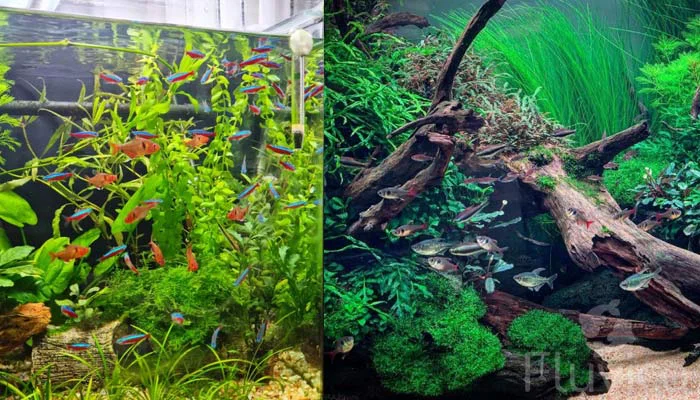
Water Quality and Parameters
Ensuring optimal water quality is paramount for a thriving tetra aquarium. Most Tetras, being sensitive, necessitate specific water conditions to flourish.
- pH: Ideal for tetras is a slightly acidic to neutral pH, typically between 6.0 to 7.5.
- Temperature: Being tropical, tetras favour a warm 22°C to 28°C range.
- Salinity: As freshwater species, tetras need near-zero salinity. Occasional minimal aquarium salt can be beneficial against diseases.
- Hardness: Tetras best adapt to soft to medium hard water, within a 3-12 dH range.
- Ammonia, Nitrite, and Nitrate: Tetras require ammonia and nitrite levels at zero. Maintain nitrates below 20 ppm for optimal health.
- Water Change: To maintain quality, change 10-20% of water weekly, ensuring a balanced environment.
- Lighting: While tetras aren’t overly fussy about lighting, they do appreciate subdued lighting that mimics their natural shaded habitats. Additionally, the right lighting accentuates their vibrant colours. However, always ensure there are darker spots or shaded areas within the tank for them to retreat to if needed.
Tank Filtration System
The filtration system serves as the lifeblood of an aquarium, ensuring clean and safe water for its inhabitants. For most tetras, an effective filtration system is crucial for several reasons: Importance:
- Removal of Waste: Filters help in removing uneaten food, organic waste, and detritus, which can otherwise degrade water quality and lead to ammonia spikes.
- Biological Filtration: Beneficial bacteria grow on the filter media, which convert harmful ammonia and nitrite (by-products of fish waste) into less harmful nitrate. This process, known as the nitrogen cycle, is vital for maintaining a healthy tank environment.
- Gas Exchange: Proper water circulation ensures adequate oxygen is available for fish and plants while also facilitating the escape of harmful gases like carbon dioxide.
- Consistent Water Parameters: With the removal of contaminants, filters help in stabilizing water parameters, ensuring the pH, hardness, and other factors remain within a safe range for tetras.
Best Practices:
- Choose the Right Size: The filter should cater to the tank’s volume, typically processing all the tank water 3-4 times per hour.
- Regular Maintenance: Clean the filter and replace the media as recommended by the manufacturer. Over time, debris can clog the system, reducing its efficiency.
- Avoid Overcleaning: While it’s essential to keep a filter clean, avoid overcleaning, especially the biological media. This can disturb the beneficial bacteria colonies, destabilizing the nitrogen cycle.
- Multiple Filtration: Combining different filtration methods, like mechanical, biological, and chemical, provides comprehensive water cleaning.
- Gentle Flow: Tetras prefer calm waters, so it’s essential to choose a filter that doesn’t create strong currents. An adjustable flow rate can be beneficial.
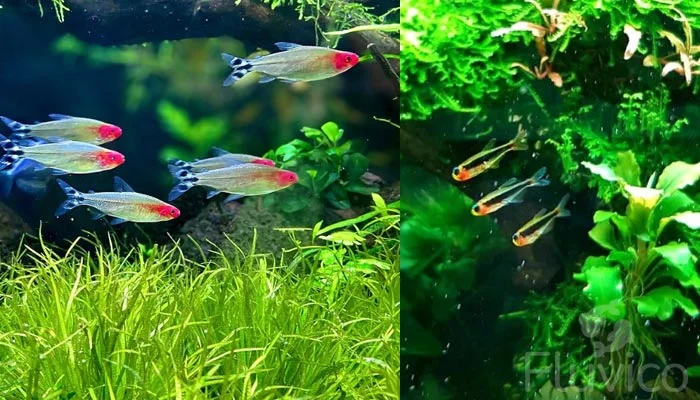
Décor and Plants
The aesthetics of an aquarium isn’t just about making it pleasing to the human eye. Properly chosen décor and plants also serve vital roles in providing a natural and comfortable habitat for tetras. Let’s delve into how you can enhance your tank for these beautiful swimmers. Decorations: What’s Best for Tetras:
- Driftwood and Rocks: Pieces of driftwood and smooth stones can mimic a natural riverbed environment. Not only do they add visual appeal, but they also offer tetras hiding spots and territories.
- Caves and Hideouts: Small caves or clay pots can be included for tetras to take refuge when they feel threatened.
- Background: A darker background (either painted or a background film) can make the vibrant colours of tetras pop and make them feel more secure.
- Avoid Sharp Objects: Ensure that all decorations are free of sharp edges to prevent potential injuries to the delicate fins of tetras.
- Natural Look: Tetras thrive best in an environment that closely mimics their natural habitat. Choosing decorations resembling their native freshwater ecosystems in South America, like Amazonian themed decorations, can make them feel more at home.
Plants for Tetra Fish:
- Broad Leaf Plants: Varieties like Amazon swords or Cryptocoryne provide broad leaves for tetras to rest on and shade underneath.
- Floating Plants: Plants like duckweed or water lettuce offer shade and protection from above, simulating a canopy.
- Dense Planting: Plants like Java moss or Java fern can be densely packed to offer hiding spots and breeding areas.
- Stem Plants: Plants such as hornwort or cabomba can be planted in the background. Their feathery nature provides excellent cover and adds depth to the aquarium.
- Maintenance: Regularly trim and prune the plants to ensure they don’t overtake the tank. This maintains adequate swimming spaces for the tetras.
Tetra Behaviour and Compatibility
Tetras, with their vibrant hues and dynamic personalities, can be the highlight of any freshwater aquarium. However, understanding their behaviour and ensuring they coexist peacefully with other tank inhabitants is essential.
Schooling and Social Behaviour
Tetras are inherently schooling fish, meaning they prefer the company of their own kind. This collective behaviour is not just a sight to behold but is deeply rooted in their survival instincts. The Importance of Schooling for Tetras:
- Safety in Numbers: In the wild, schooling offers protection from predators. A larger group confuses predators, making it challenging to single out one individual.
- Social Interaction: Schooling provides tetras with essential social interactions, enhancing their mental well-being.
- Stress Reduction: Lone tetras can become stressed, which can lead to poor health. Being in a group offers comfort and security.
- Natural Behaviour Exhibition: In a school, tetras display fascinating coordinated swimming patterns, showcasing their natural behaviour.
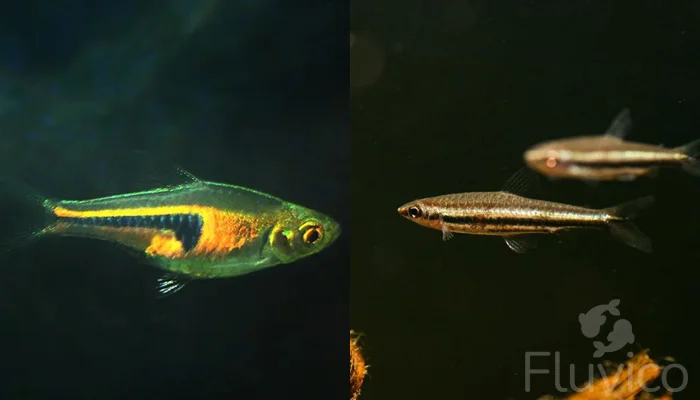
Tetras Care
Tetra Diet and Nutrition
Tetras, with their vibrant colours and active behaviour, are a popular choice for many aquarium enthusiasts. To maintain their health and vivacity, it’s essential to provide them with a balanced and nutritious diet. Let’s delve into the dietary requirements of tetras. Staple Diet:
- Flake Food: High-quality tropical fish flakes form the base of a tetra’s diet. These flakes should be rich in protein and other essential nutrients.
- Pelleted Food: Mini and micro pellets are ideal for tetras due to their small mouth size. These can serve as a staple or supplementary food source.
Live and Frozen Foods:
- Brine Shrimp: Baby brine shrimp or Artemia is a protein-packed food source that tetras love. They can be fed live or in frozen form.
- Bloodworms: These can be given occasionally and serve as a treat. They provide an excellent protein source but should be offered in moderation.
- Daphnia and Moina: These small crustaceans are another favourite, providing both entertainment and nutrition as tetras hunt them down.
Vegetable Matter:
- Spirulina Flakes: Rich in essential vitamins and minerals, spirulina flakes are a great addition to a tetra’s diet.
- Blanched Vegetables: Small pieces of blanched spinach, zucchini, or peas can be given occasionally to offer variety and essential nutrients.
Vitamin and Supplements:
- Vitamin Drops: Adding vitamin drops to the water or food can help ensure tetras receive all the necessary nutrients.
- Calcium Supplements: Especially if you have soft water, a calcium supplement can support bone health in tetras.
Feeding Guidelines:
- Frequency: Feed tetras 1-2 times daily, giving only as much as they can consume within 2-3 minutes to avoid overfeeding.
- Variety: Offer a mix of foods for balanced nutrition. This ensures they receive all the essential nutrients and keeps them interested in feeding.
- Observation: Always monitor your tetras during feeding. Their eagerness to eat and overall condition can be an indicator of their health.
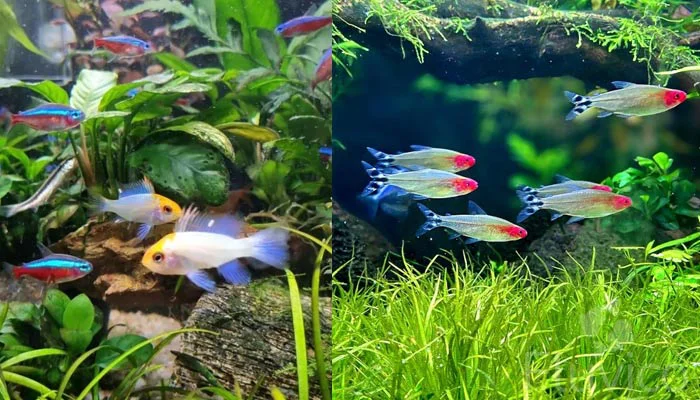
Best and Worst Tank Mates
When setting up an aquarium for tetras, it’s crucial to ensure they cohabit with compatible tank mates. Although tetras are generally placid, their petite stature makes them easy prey for larger, predatory fish. Here’s a guideline to aid in choosing the best and least suitable companions for tetras:
Best Tank Mates
- Other Tetra Species: Different tetra types typically coexist harmoniously. Neon Tetras, Cardinal Tetras, or Rummy-Nose Tetras are worthy considerations.
- Corydoras Catfish: These peaceful, bottom-dwelling fish won’t interfere with the tetras. They’re also beneficial, consuming uneaten food.
- Small Rasboras: Fish like the Harlequin Rasbora are peace-loving and are a good match in size for tetras.
- Dwarf Gouramis: These tranquil surface residents add vibrancy to your aquarium.
- Otocinclus Catfish: Efficient algae consumers, they coexist peacefully with tetras.
- Dwarf Shrimp: Varieties like the Cherry Shrimp can live harmoniously with tetras.
- Scarlet Badis: This small, colorful fish is peaceful and can be a good companion for tetras, given their similar size and temperament.
Worst Tank Mates
- Cichlids: Several cichlids are aggressive and might view tiny tetras as a meal, particularly larger ones like Oscars.
- Bettas: Sometimes they can cohabit peacefully, but male bettas could perceive brightly coloured tetras as adversaries and become hostile.
- Barbs: Some species, like the Tiger Barb, are notorious fin-nippers and can bully tetras.
- Large Catfish: Types such as the Red-Tailed Catfish will likely consider tetras a food option.
- Aggressive Plecos: Some plecos, especially the larger, more combative varieties, can pose a threat to tetras.
- Freshwater Sharks: Bala Shark and Rainbow Shark may live peacefully with tetras when young, but can become territorial with age. Black Sharks and Silver Tip Sharks are generally not recommended with tetras due to their dominant nature.
- Angelfish: While they’re often kept with tetras, angelfish can sometimes prey on smaller tetras, especially when they mature.
- Archer Fish: These fish are brackish water inhabitants and have a tendency to spit water to knock down prey. Their unique requirements and behavior make them a less suitable companion for tetras.
When selecting tank mates for tetras, it’s imperative to consider the distinct needs and temperaments of all the fish. Your aim should be a balanced ecosystem where every aquatic creature can flourish without intimidation or the threat of predation.

Health Concerns
Like all aquatic creatures, tetras can face health issues if their environment isn’t ideal or if they’re exposed to stressors. Recognising and addressing these health concerns promptly can make all the difference in ensuring a long, healthy life for your tetra fish.
Common Tetra Diseases:
- Fin Rot: Characterised by fraying or discolouration of the fins. Often caused by bacterial infections, it requires a clean tank environment and medication to treat effectively.
- Ich (Ichthyophthirius multifiliis): This parasitic infection manifests as tiny white spots covering the fish’s body. It is treatable with increased tank temperatures and specific anti-parasitic medications.
- Neon Tetra Disease: A fatal condition affecting Neon Tetras specifically. It causes pale patches and spine curvature. There’s no known cure, and affected fish should be quarantined to prevent spread.
- Swim Bladder Disease: Tetras with this ailment may float upside-down or seem unable to maintain their balance. It’s often a result of overfeeding or poor diet.
Preventative Measures:
- Regular Water Changes: Maintaining a clean environment reduces the chance of diseases. Aim for a 10-20% water change weekly.
- Quarantine New Fish: Before introducing new fish to your tank, keep them in a separate quarantine tank for 2-3 weeks. This can help in preventing the spread of potential diseases.
- Maintain Proper Water Parameters: Tetras thrive in specific pH, temperature, and salinity conditions. Regularly test the water to ensure it remains within the optimal range.
- Feed a Balanced Diet: Proper nutrition bolsters a fish’s immune system, making them less susceptible to diseases.
- Avoid Overcrowding: Overstocking your tank can lead to stress and poor water quality, both of which can increase the risk of disease.
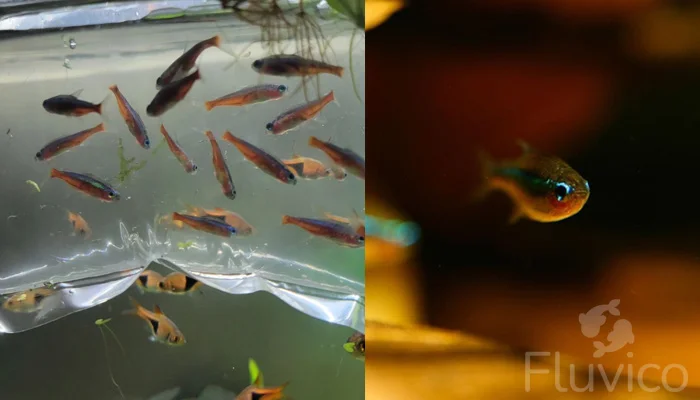
Tetra Breeding
Breeding tetras is a rewarding experience for many aquarium hobbyists. While the exact methods and timescales can differ slightly depending on the specific species of tetra, here’s a general overview of breeding tetras:
Total Time: Roughly 5-10 weeks
1. Setting up the Breeding Tank:
Choose a separate tank for breeding, typically smaller than the main tank (10-20 gallons). The water should be soft and slightly acidic, mimicking natural conditions. Install a sponge filter for gentle filtration and provide hiding spots using plants like java moss.
2. Choosing and Conditioning the Breeding Pair:
Select a healthy, mature pair (male and female). Feed them a high-quality, varied diet, including live and frozen foods, to get them into breeding condition.
3. Introducing the Breeding Pair to the Breeding Tank:
This transition is either instant or can take several hours. After conditioning, transfer the breeding pair to the breeding tank in the evening, as tetras often spawn at dawn.
4. Spawning:
Tetras scatter their eggs, often amongst plants. Some tetras might spawn after a few days in the breeding tank, while others can take up to a week.
5. Post-Spawning:
Immediately after spawning, remove the parents from the breeding tank to prevent them from eating the eggs.
6. Egg Hatching:
The eggs typically hatch 24-72 hours (1-3 days) post-spawning, depending on the species and water conditions.
7. Fry Care:
Once hatched, the fry will consume their yolk sacs for the first few days. After 2-4 days, start feeding them infusoria or specially formulated fry foods. As they grow, introduce them to brine shrimp nauplii and, eventually, finely crushed flake food.
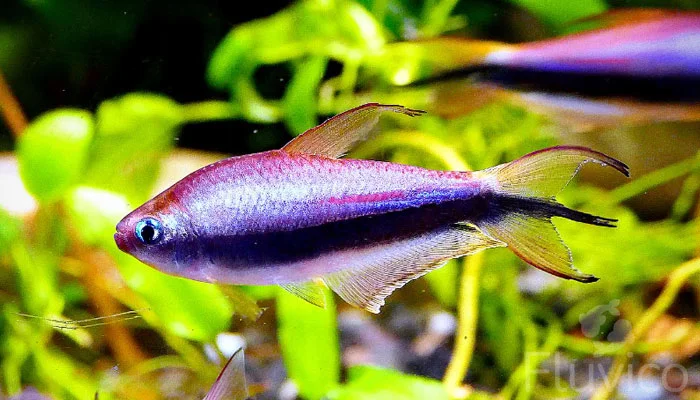
FAQ
How many Tetras should be kept together?
Tetras are schooling fish and should be kept in groups of at least 6 or more to ensure they feel secure and exhibit natural behaviours.
Are Tetras hard to keep alive?
Tetras are generally hardy fish, but they require consistent water quality, proper feeding, and suitable tank mates to thrive. With the right care, they can live healthily in a home aquarium.
Do Tetras need to eat every day?
Tetras should be fed two to three times daily. Provide a few flakes per fish, ensuring they consume all within two minutes. Avoid overfeeding as this can harm the water and the fish.
Do Tetras multiply fast?
Tetras can breed regularly in ideal conditions, but their multiplication rate isn’t as rapid as some other fish species. Successful breeding requires specific conditions and care.
More Reading

15 Types of Cryptocoryne: Which is Best For Your Aquarium Setup?

16 Awesome Low Light Aquarium Plants (Mosses, Ferns & Stem Plants)


18 Types of Aquarium Moss: Photos, Care, Propagation & Growth Guide
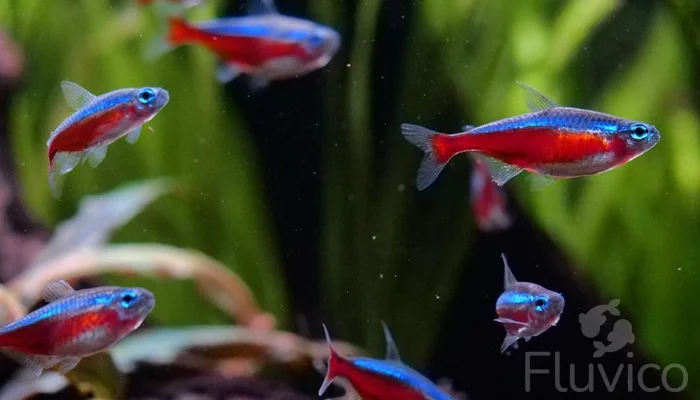

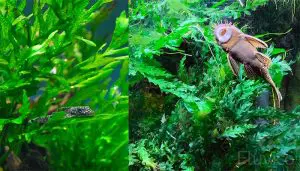

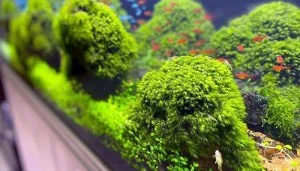

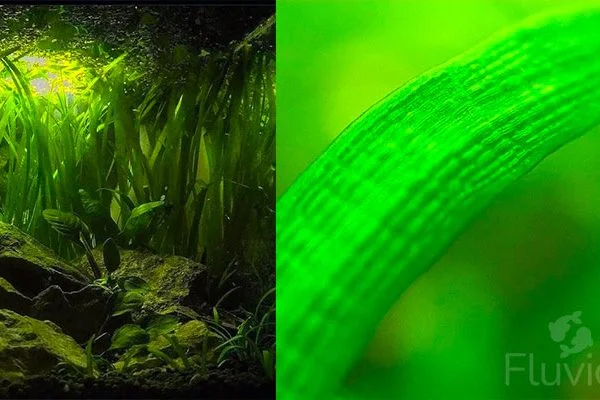


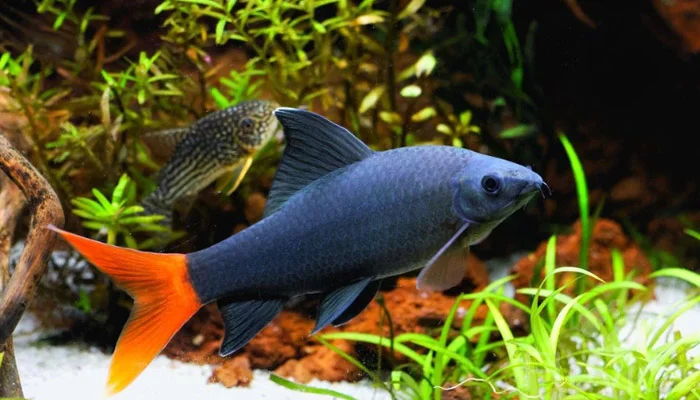

Hope you enjoyed our Tetra Care Guide!
If you have any questions? Ask away, we’re here to help!
All the best,
Daniel